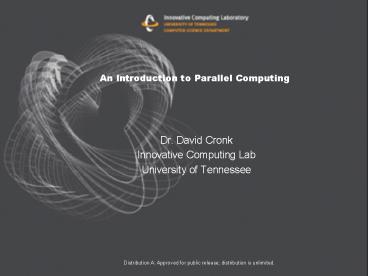An Introduction to Parallel Computing PowerPoint PPT Presentation
Title: An Introduction to Parallel Computing
1
An Introduction to Parallel Computing
- Dr. David Cronk
- Innovative Computing Lab
- University of Tennessee
Distribution A Approved for public release
distribution is unlimited.
2
Outline
- Parallel Architectures
- Parallel Processing
- What is parallel processing?
- An example of parallel processing
- Why use parallel processing?
- Parallel programming
- Programming models
- Message passing issues
- Data distribution
- Flow control
3
Shared Memory Architectures
Single address space All processors have access
to a pool of shared memory Symmetric
multiprocessors (SMPs) Access time is uniform
CPU
CPU
CPU
CPU
CPU
bus
Main Memory
4
Shared Memory Architectures
Single address space All processors have access
to a pool of shared memory Non-Uniform Memory
Access (NUMA)
Network
5
Distributed memory Architectures
M
M
M
M
M
M
M
M
P
P
P
P
P
P
P
P
Network
6
Networks
- Grid processors are connected to 4 neighbors
- Cylinder A closed grid
- Torus A closed cylinder
- Hypercube Each processor is connected to 2n
other processors, where n is the degree of the
hypercube - Fully Connected Every processor is directly
connected to every other processor
7
Parallel Processing
- What is parallel processing?
- Using multiple processors to solve a single
problem - Task parallelism
- The problem consists of a number of independent
tasks - Each processor or groups of processors can
perform a separate task - Data parallelism
- The problem consists of dependent tasks
- Each processor works on a different part of data
8
Parallel Processing
We can approximate the integral as a sum of
rectangles
9
Parallel Processing
10
Parallel Processing
11
Parallel Processing
- Why parallel processing?
- Faster time to completion
- Computation can be performed faster with more
processors - Able to run larger jobs or at a higher resolution
- Larger jobs can complete in a reasonable amount
of time on multiple processors - Data for larger jobs can fit in memory when
spread out across multiple processors
12
Parallel Programming
- Outline
- Programming models
- Message passing issues
- Data distribution
- Flow control
13
Parallel Programming
- Programming models
- Shared memory
- All processes have access to global memory
- Distributed memory (message passing)
- Processes have access to only local memory. Data
is shared via explicit message passing - Combination shared/distributed
- Groups of processes share access to local data
while data is shared between groups via explicit
message passing
14
Message Passing
- Message passing is the most common method for
programming for distributed memory - With message passing, there is an explicit sender
and receiver of data - In message passing systems, different processes
are identified by unique identifiers - Simplify this to each having a unique numerical
identifier - Senders send data to a specific process based on
this identifier - Receivers specify which process to receive from
based on this identifier
15
Parallel Programming
- Message Passing Issues
- Data Distribution
- Minimize overhead
- Latency (message start up time)
- Few large messages is better than many small
- Memory movement
- Maximize load balance
- Less idle time waiting for data or synchronizing
- Each process should do about the same work
- Flow Control
- Minimize waiting
16
Data Distribution
17
Data Distribution
18
Flow Control
19
This presentation was made possible through
support provided by DoD HPCMP PET activities
through Mississippi State University (MSU) under
contract No. N62306-01-D-7110.

